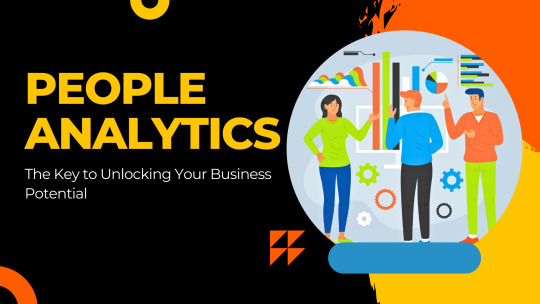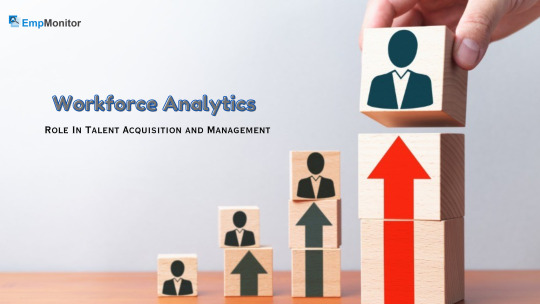#Workforce Analytics
Explore tagged Tumblr posts
Text
0 notes
Text
The Role of People Analytics in Modern Management
No aspect of modern management moves ahead without making data-driven decisions. What’s more, the organisations of today are leveraging people analytics to optimise employee performance, improve employee engagement and bank on strategically created decision-making. That said, with access to the right tools, organisations can evaluate their own workforce, the current workforce trends, predict future needs and requirements and even boost overall efficiency. This blog further writes and showcases how people analytics is designed to model management strategies and revolutionise HR systems.
Absorbing & Digesting People Analytics in Management
People analytics is defined as the practice of using received data to measure, deeply analyse and improve the performance of your workforce. By gathering the accumulated insights from the HR on employees’ productivity, engagement and retention, organisations can make better and informed decisions that can lead to elevated business outcomes. Traditionally HR management used intuition and qualities, but the current workforce analytics enables leaders of companies to take advantage of hard data and use it to build as well as enhance strategic workforce planning strategies.
Organisations that employ these same workforce planning strategies are able to foresee incoming challenges, track the performance and create adaptable and actionable solutions. Multinational companies such as Google and Microsoft are already utilising employee analytics to polish their hiring, training and retention processes.
Decision-making That Is Driven By Data
Effective leadership today also depends how well the data-driven decision-making is. As mentioned above, by utilising HR analytics tools, companies are well-equipped to gain beneficial insights into employee conduct, performance, satisfaction and productivity levels. All of them help the manager make cognisant decisions rather than putting their faith on guesswork or subjective written or oral opinions.
For example, companies that proactively track employee engagement metrics can identify signs of burnout in the early stages and take measures at once. As per a study by Gallup, organisations with highly engaged employees experience a 23% jump in profitability. Workforce analytics help businesses understand which specific factors contribute to employee satisfaction and enable them to implement strategies which heighten motivation and retention.
Key Areas Where People Analytics Make a Striking Impact
Performance Analytics – Employees Calculating employee performance is no longer limited to annual reviews only. Organisations now have complete access to real-time performance metrics to track productivity status and identify areas of improvement. Performance analytics includes accessing key indicators such as completion rates, project efficiency and overall company objectives.
Planning Strategies – Workforce Ensuring that the right talent is in position to meet the desired business objective is workforce planning. People analytics assist organisations to anticipate future hiring needs, assess skill gaps and allocate resources accordingly and effectively.By methodically analysing turnover rates, recruitment trends and employee capabilities, companies have everything that is needed to create long-term workforce planning strategies. For example, a company facing high attrition rates in a specific department of their workforce can use HR data insights to find underlying issues and develop targeted strategies accordingly.
HR Data Insights – Talent Acquisition Business success comes down to hiring the right talent. Talent analytics strategies allow recruiters to recognise top candidates based on past hiring data, skills and their assessments and behavioural insights. With AI booming, AI-driven analytical tools have developed the capacity to analyse resumes, previous job performances and interview reviews to answer which candidates will fit the role perfectly. This can reduce hiring bias and improves the quality of the new hires. Companies such as Amazon use prognostic hiring models to match candidates with job roles that align with their skills and career goals.
Employee Engagement & Retention - Enhancement A motivated workforce is a productive workforce. People analytics in employee management helps organisations to observe employee engagement levels through pulse surveys, sentiment analysis and feedback tools.If it reveals that there’s a certain drop in engagement of certain teams, HR can follow-up with immediate action. Whether it is by addressing workplace or cultural problems, providing professional development programs or re-adjusting assigned workloads. Research by Harvard Business Review found that companies using people analytics for engagement see a 31% reduction in employee turnover.
The Future of People Analytics in Management
As technology continues to advance, the role of people analytics in management will become even more significant. Future trends include:
AI & Machine Learning Integration: With AI rising beyond expectations, AI-powered workforce analytics will enable prognostic modelling, helping companies to anticipate workforce trends and make proactive decisions.
Real-Time Employee Feedback: Businesses will implement AI-driven sentiment analysis tools to gauge employee satisfaction in real-time.
Remote Work Analytics: With hybrid and remote work becoming the norm, people analytics will help organizations optimise productivity and engagement for distributed teams.
Diversity & Inclusion Metrics: Companies will leverage HR data insights to track and improve diversity, equity and inclusion (DEI) initiatives.
How Can Organisations Make Use Of People Analytics Effectively
To successfully utilise the maximum potential of People Analytics, organisations should follow the following steps:
Invest in HR analytical tools that offer comprehensive analytical solutions.
Establish clear Key Performance Indicators (KPIs) that align accurately with your business objectives.
Train HR and Managers to interpret data and apply insights effectively.
Ensure Data Privacy and Compliance to preserve ethical standards while adhering to data protection regulations.
Foster a Data-driven Culture where decisions are taken after being informed by analytic tools rather than intuition alone.
Coming To The Conclusion
The integration of people analytics in management is transforming how organisations make decisions about talent, performance and engagement. By leveraging workforce analytics and HR data insights, companies can drive productivity, enhance employee experience, and develop more effective workforce planning strategies.
Data-driven decision-making is no longer optional, it’s essential for staying competitive in today’s business environment. As technology continues to evolve, organisations that embrace people analytics will without a doubt be better equipped to steer workforce challenges and build a thriving, engaged workforce.
Are you ready to harness the power of people analytics in your organization? Start implementing the right HR analytics tools today and unlock the full potential of your workforce.
0 notes
Text
What’s Missing From Your Recruitment Metrics? Tracking ‘Cost-Per-Quality-Applicant’ Can Bridge the Gaps
Once considered groundbreaking for the HR industry, data and analytics are now a key business driver for companies looking to maximize budget, improve hiring KPIs, strengthen employee retention and engagement, and more. In today’s market, most businesses are tracking their recruitment marketing investments to get a better understanding of their costs and performance in order to enhance their talent acquisition (TA) strategy. These metrics, including job ad impressions, clicks, and application volume, allow HR and TA professionals to make data-driven decisions that strategically inform their campaigns.

While there is a plethora of insights to be gained from these various advertising metrics, it’s crucial that businesses track quality data allowing them to connect the dots between the top-of-funnel campaign performance and the recruitment process.
Understanding Current Recruitment Metrics
Today’s labor market leaves many recruiting teams stretched thin and struggling to get the right amount of HRIS or data analytics support to fully grasp the return on investment from their recruitment advertising.
The most basic metrics, while still helpful, focus more on quantity over quality. Using this approach can result in hidden costs and inefficiencies as many HR professionals are left without specific insights about what channels are driving quality candidates to their career sites.
Oftentimes, the go-to performance metrics for recruitment advertising campaigns are impressions or clicks, measuring how many people have seen or engaged with a particular campaign. However, the conversion from impression to click (known as click-through rate or CTR) does not typically equate to a full application or, more importantly, a quality application. There’s a large disconnect in the industry as to which sources are driving applicants to make it further in the recruitment process, but analytics tied to quality metrics can help bridge this gap.
The Call to Measure Quality Metrics
Quality metrics take into account an organization’s recruitment operations and functionality, providing insight into the dynamic nature of priority job openings that attract top talent. It’s important to keep in mind that “quality” is not a one-size-fits-all.
The quality metric that works for a particular organization can and likely will be different from others depending on specific objectives and the recruitment process. For instance, evaluating cost per applicant (CPA), cost per quality applicant (CPQA), and cost per hire (CPH) can help produce more accurate metrics than simply relying on time-to-fill or quantity of applicants.
CPQA is a significant measurement because it provides insight into how much a company has invested in a campaign to yield a “qualified” candidate for a particular role. Additionally, evaluating CPH identifies the cost of bringing a candidate into the recruiting process and ultimately, over the finish line as a hire for an organization. Knowing how much it costs to secure a qualified applicant and ultimately a hire provides essential insight for HR teams to forecast recruitment budgets based on the number of hires needed, better align with workforce plans and long-term business goals, and create enhanced strategies that further optimize output via recruitment marketing channels.
Transform Business Operations with CPQA
Given a better understanding of advertising and applicant performance, teams can level up their recruitment marketing strategy even further. Leveraging reporting through an applicant tracking system (ATS) allows visibility into quality metrics so HR teams can better execute their recruiting initiatives and hiring objectives that correspond with overall business operations.
Having an understanding of the channels that drive more qualified candidates can positively impact job satisfaction. By attracting better-suited candidates, organizations can improve long-term employee retention. Under these circumstances, business operations are enhanced because of cost-effective recruitment sources and reduced turnover rates.
Lastly, and of equal importance, data-driven insights provide enriched strategic planning that benefits employer branding. Developing recruitment strategies that align with a company’s growth plan, identity, and offerings only maintains a stronger feedback loop of quality candidates.
How to Implement CPQA into the Recruitment Process
To measure CPQA, one must first understand an organization’s unique recruitment process. This may involve working with the ATS administrator or HRIS team to define what the various stages of the recruitment process look like. The stages within a sample recruitment workflow could be New Applicant, Initial Review, Phone Screen, Hiring Manager Review, Hiring Manager Interview, Offer, and Hire. Keep in mind, depending on organizational structure, the stages within this process could vary between different groups or functional areas.
Thirdly, track applicants associated with each recruitment channel. When activating recruitment marketing campaigns, establish source tracking tied to each advertising channel, as defined within the ATS. Since each ATS captures source tracking differently, pay attention to how these source codes are appended to campaign URLs. The origination of a job seeker’s click can offer further insight into what advertising channels are working. Again, this may involve working internally with the HRIS team and/or recruitment marketing agency partner.
From there, measure costs and calculate CPQA/CPH for different channels. Ensure that there is a handle on the costs tied to each advertising channel the team is leveraging for recruitment marketing efforts. Capturing and centralizing these costs is paramount to measuring CPQA and ultimately CPH.
Quality is Calling: Reevaluate Your Metrics Today
In today’s quickly evolving job market, these types of data-driven insights provide organizations the ability to make strategic decisions to revolutionize the workforce, HR teams, and business operations. Better analytics and a more dynamic recruiting channel strategy allow organizations to shift their budget toward more flexible pay-per-performance and employer branding channels instead of being locked away in underperforming initiatives. Begin capturing quality metrics to build better recruitment marketing campaigns that reinforce employer brand and increase quality applicant flow, leading to more easily filled roles and better return on investment.
Explore Hrtech Articles for the latest Tech Trends in Human Resources Technology
#HR Tech#Technology#Recruitment Metrics#Cost-Per-Quality-Applicant#Hiring Efficiency#Talent Acquisition#Workforce Analytics
0 notes
Text
People Analytics: The Key to Unlocking Your Business Potential

Imagine if you could unlock your business's hidden potential with the power of data—not just numbers and spreadsheets, but deep insights into your organization's most valuable asset: your employees.
In today’s rapidly evolving business landscape, success isn’t just about having the right product or strategy; it’s about having the right team working in the right way. As a result, people analytics comes into play, transforming and altering how businesses manage their staff.
It turns employee data into a goldmine of actionable insights, helping organizations hire smarter, engage their workforce more effectively, and optimize performance. It’s more than just an HR tool. It’s a strategic advantage that drives growth, innovation, and success.
Ready to tap into this game-changing approach? Let’s explore how to unlock your business's true potential.
What is People Analytics?
This analytics is the process of using data to gain insights into various aspects of the workforce, such as employee performance, engagement, and overall organizational health. Also known as HR or workforce analytics, this data-driven approach involves gathering and evaluating employee-related metrics, including hiring trends, turnover rates, and productivity levels. By turning raw data into meaningful insights, it enables businesses to make informed decisions that optimize their workforce, improve business outcomes, and boost employee productivity.
The Benefits of People Analytics

Integrating this into a company's strategy gives several valuable benefits:
Improved Hiring and Talent Management
It revolutionizes hiring by using data to identify the traits of successful employees, leading to smarter recruitment decisions. It also helps manage talent by pinpointing skill gaps and high-potential individuals, enabling personalized development plans and better employee growth. This method reduces turnover and ensures a more efficient and skilled workforce.
Increased Employee Engagement and Retention
It enhances employee engagement by identifying and addressing factors that lead to dissatisfaction. By understanding the drivers of disengagement, companies can make targeted improvements, leading to greater job satisfaction and lower turnover rates. This proactive approach not only keeps employees motivated but also reduces the costs and disruptions associated with frequent staff changes.
Enhanced Productivity and Performance
It helps businesses increase productivity by identifying trends and inefficiencies in work processes. Companies can use performance data to optimize processes, remove productivity obstacles, and improve team dynamics. This data-driven strategy improves workflows, resulting in greater efficiency and a more productive workforce.
Data-Driven Decision Making
It improves decision-making by replacing guessing with reliable facts. It enables businesses to make decisions based on genuine information, whether they are enhancing pay plans, scheduling organizational changes, or maximizing resource allocation. This method reduces risks and ensures that decisions are aligned with strategic goals, resulting in more accurate and effective outcomes.
Popular People Analytics Tools

Here are trendy tools:
EmpMonitor: Provides detailed insights into workforce behavior, helping businesses track performance and productivity.
Workday: Provides comprehensive HR analytics and reporting capabilities, integrating data from various HR functions to offer insights into workforce trends, performance, and engagement.
SAP SuccessFactors: Offers advanced analytics features that help organizations analyze employee data, manage talent, and track key metrics for better decision-making and strategic planning.
ADP DataCloud: Delivers powerful analytics for workforce data, helping businesses understand trends, optimize HR processes, and improve employee experience and performance.
Tableau: Allowing organizations to create custom dashboards and analyze workforce data in depth.
Visier: Providing actionable insights into employee performance, retention, and engagement.
Also, watch this video - How to Set Productivity Rules On EmpMonitor
youtube
Final Thoughts
People analytics is no longer a luxury reserved for large corporations; it is a necessity for businesses looking to stay competitive in the modern landscape. By harnessing the power of data, organizations can unlock valuable insights into their workforce, improve employee engagement and retention, and drive productivity. With advanced people analytics tools, businesses have exceptional access to insights that drive success. Ultimately, It is the key to unlocking your business potential, enabling smarter decisions and better outcomes in every aspect of the organization.
#people analytics#workforce analytics#people management#workforce management#people analytics tools#Youtube
0 notes
Text
The Role of Workforce Analytics in Talent Acquisition and Management

The ability to effectively manage and develop talent is crucial for organizational success. It is where workforce planning comes into play. workforce planning analytics is a powerful tool that helps organizations understand and optimize their workforce by leveraging data and advanced analytical techniques. Here we go to explore workforce analytics, its role in talent acquisition and management, and how workforce planning and analytics can drive business success. We'll also discuss the importance of workforce management software in this process.
What is Workforce planning?
Workforce planning involves the use of statistical and analytical methods to understand workforce data and gain insights into employee performance, behavior, and trends. It encompasses a range of activities, from basic reporting and metrics to advanced predictive analytics. The primary goal of workforce planning is to provide actionable insights that help organizations make informed decisions about their workforce.
Components of workforce planning
Data Collection: Collect data from different seeds such as HR strategies, employee surveys, and performance reviews.
Data Analysis: Using statistical tools and techniques to analyze the collected data.
Reporting and Visualization: Presenting the analyzed data in a clear and understandable format through dashboards and reports.
Predictive Analytics: Using historical data to predict future trends and behaviors.
The Function of Workforce Planning Analytics in Talent Acquisition
Talent acquisition is the process of finding and hiring the right talent for an organization. Workforce planning analytics plays a crucial role in this process by providing insights that help organizations identify, attract, and retain top talent.

Identifying Talent Gaps
Workforce planning analytics helps organizations identify gaps in their current workforce. By analyzing data on employee skills, performance, and turnover rates, organizations can determine which areas need improvement and where there are growth opportunities.
Enhancing Recruitment Strategies
With workforce planning analytics, organizations can optimize their recruitment strategies. For example, by analyzing data on successful hires, organizations can identify the most effective recruitment channels, the best time to hire, and the characteristics of top-performing employees.
Improving Candidate Selection
Workforce research can also improve the candidate selection process. By analyzing data on past hires, organizations can develop predictive models that identify the characteristics of successful employees. It helps in screening candidates more effectively and making better hiring decisions.
The Role of Workforce Planning Analytics in Talent Management
Talent management involves developing and retaining employees to ensure they reach their full potential. Workforce planning is essential in this process as it provides insights into employee performance, engagement, and development needs.
Employee Engagement
Engaged employees are more effective and less likely to exit the institution. Workforce analysis can help measure employee engagement through surveys and other data sources. By analyzing this data, organizations can identify areas where engagement is low and develop strategies to improve it.
Learning and Development
Workforce analysis can identify the skills and competencies that employees need to develop. This information is crucial for designing training and development programs that help employees grow and succeed in their roles.

Workforce Planning and Analytics
Workforce planning and analytics involve the systematic identification and analysis of workforce data to ensure that an organization has the right people with the right skills in the right roles at the right time. This process is essential for long-term business success.
Strategic Workforce Planning
Strategic workforce planning involves forecasting future workforce needs based on business goals and objectives. Workforce planning analytics helps organizations predict future talent requirements and develop strategies to meet these needs. It includes identifying critical roles, assessing the availability of talent, and developing succession plans.
Operational Workforce Planning
Operational workforce planning focuses on the short-term needs of the organization. It involves analyzing current workforce data to identify immediate talent gaps and developing strategies to address these gaps. Workforce planning and analytics provide the data and insights needed to make informed decisions about hiring, training, and deployment.
The Importance of Workforce Management Software

Workforce management software is a critical tool for implementing workforce analysis. It provides the necessary infrastructure for collecting, analyzing, and reporting workforce data.
Data Integration: Integrates data from various sources, providing a comprehensive view of the workforce.
Analytics and Reporting: Offers advanced analytics and reporting capabilities to provide actionable insights.
Performance Tracking: Tracks employee performance and provides tools for performance management.
Engagement Surveys: Facilitates the collection and analysis of employee engagement data.
Predictive Analytics: Uses predictive models to forecast future trends and behaviors.
You Can Also Watch:
youtube
Wrapping Words
Workforce analytics is a powerful tool that plays a critical role in talent acquisition and management. By leveraging workforce planning and analytics, organizations can identify talent gaps, enhance recruitment strategies, and improve candidate selection. Workforce analysis also supports talent management by providing insights into performance, engagement, and development needs. With the help of workforce management software, organizations can effectively implement workforce analytics and drive business success.
#workforce analytics#workforce planning and analytics#workforce planning analytics#what is workforce analytics#workforce management software#Youtube
0 notes
Text
Learn the Importance of Workforce Planning and how the key elements and Strategic Insights consider help of labor market analytics.
0 notes
Text
Empower Data-Driven Decision-Making: Agile HR Analytics New Release!
#People Analytics#HR Analytics#Workforce Analytics#Attrition Dashboard#Human Capital Analytics#HR Dashboards#HR Metrics Dashboards#Employee Dashboards#HR Reporting#Power BI HR
0 notes
Text
How can workforce analytics help manage efficiency in remote work?
Flexible work brings multiple benefits but demands managing time and efficiency for remote teams operating distributed across locations. With 51% of the remote workforce experiencing disengagement at work, organizations need to stay in sync with how teams work and what efficiency they gain. Why workforce analytics is importantGain intelligence on employee performanceExtract inefficiencies at…

View On WordPress
#Desktop Monitoring Software#Employee Monitoring Software#Employee Time Tracking Software#Productivity and Compliance#Productivity Monitoring Software#Remote Employee Monitoring Software#Remote Work#Workforce Analytics
0 notes
Text

Discover the essential skills for a data scientist, including a relevant degree, knowledge of parallel fields, strong communication abilities, teamwork, and industry understanding. Learn why these skills are crucial for success in this dynamic field. https://www.rangtech.com/blog/data-science/skill-sets-required-to-be-a-data-scientist
#data science#machinelearning#artificial intelligence#big data#workforce analytics#workforce#talent acquisition#workforcesolutions#it talent acquisition#hr consultancy
0 notes
Text
#"hr planning#annual calendar#hr calendar#hr strategic plan#workforce analytics#yearly calendar#human resource planning#annual planner#hr training program#hr plan for a startup company#hr calendar 2023#hr compliance calendar#annual planner 2023#hr calendar of activities 2023#hr wellness programs#incentive plan for hr employees#hr schedule#hr annual planning calendar#hr annual calendar of events#hr events calendar#annual hr calendar#hr planning calendar#hr yearly calendar#human resources annual planning calendar#quarterly planning calendar#annual planning calendar
0 notes
Text
0 notes
Text
Empower your business with data-driven decisions! Big Data Analysis and Machine Learning unlock insights, optimize processes, and drive innovation, ensuring you stay ahead in the digital era.

Transform raw data into powerful insights! Big Data and Machine Learning help businesses predict trends, automate workflows, and make smarter decisions for a future-ready workforce.
#bigdataanalytics#machinelearning#machinelearningalgorithms#bigdata#analytics#zitintech#zitintechnologies#itjob#jobs#hiring#workforcedevelopment#recruiting#laboursupply#technologynews#workforce#workfromhome#training#workforcesolutions#it#software#technology#itstaffing#job
8 notes
·
View notes
Text
Inside the AI Based Contact Center with Tools Tech and Trends
Introduction

The evolution of customer service has entered a new era with the rise of the AI based contact center. No longer just a support line, today’s contact centers are intelligent, data-driven hubs that utilize artificial intelligence to deliver personalized, efficient, and scalable customer interactions. As businesses race to stay ahead of the curve, understanding the essential tools, technologies, and emerging trends that power AI-driven contact centers becomes crucial. This article explores how AI is transforming contact centers and what lies ahead for this innovative landscape.
The Rise of the AI Based Contact Center
Traditional contact centers, though essential, have long suffered from inefficiencies such as long wait times, inconsistent service, and high operational costs. AI-based contact centers are solving these issues by automating routine tasks, predicting customer needs, and delivering omnichannel support.
AI technology, such as machine learning, natural language processing (NLP), and robotic process automation (RPA), is now integrated into contact center platforms to enhance agent productivity and customer satisfaction.
Essential Tools Driving AI Based Contact Centers
1. AI-Powered Chatbots and Virtual Agents
Chatbots are the most visible AI tool in contact centers. These virtual assistants handle customer queries instantly and are available 24/7. Advanced bots can handle complex conversations using NLP and deep learning, reducing human intervention for repetitive inquiries.
2. Intelligent Interactive Voice Response (IVR) Systems
Modern IVR systems use voice recognition and AI to route calls more accurately. Unlike traditional menu-based IVRs, intelligent IVRs can interpret natural language, making customer interactions smoother and faster.
3. Speech Analytics Tools
AI-driven speech analytics tools analyze live or recorded conversations in real time. They extract keywords, sentiments, and emotional cues, offering insights into customer satisfaction, agent performance, and compliance issues.
4. Workforce Optimization (WFO) Platforms
AI helps optimize staffing through forecasting and scheduling tools that predict call volumes and agent availability. These platforms improve efficiency and reduce costs by aligning workforce resources with demand.
5. CRM Integration and Predictive Analytics
By integrating AI with CRM systems, contact centers gain predictive capabilities. AI analyzes customer data to forecast needs, recommend next-best actions, and personalize interactions, leading to higher engagement and retention.
Core Technologies Enabling AI Based Contact Centers
1. Natural Language Processing (NLP)
NLP allows machines to understand, interpret, and respond in human language. This is the backbone of AI-based communication, enabling features like voice recognition, sentiment detection, and conversational AI.
2. Machine Learning and Deep Learning
These technologies enable AI systems to learn from past interactions and improve over time. They are used to personalize customer interactions, detect fraud, and optimize call routing.
3. Cloud Computing
Cloud platforms provide the infrastructure for scalability and flexibility. AI contact centers hosted in the cloud offer remote access, fast deployment, and seamless integration with third-party applications.
4. Robotic Process Automation (RPA)
RPA automates repetitive tasks such as data entry, ticket generation, and follow-ups. This frees up human agents to focus on more complex customer issues, improving efficiency.
Emerging Trends in AI Based Contact Centers
1. Hyper-Personalization
AI is pushing personalization to new heights by leveraging real-time data, purchase history, and browsing behavior. Contact centers can now offer customized solutions and product recommendations during live interactions.
2. Omnichannel AI Integration
Customers expect consistent service across channels—phone, email, chat, social media, and more. AI tools unify customer data across platforms, enabling seamless, context-aware conversations.
3. Emotion AI and Sentiment Analysis
Emotion AI goes beyond words to analyze voice tone, pace, and volume to determine a caller's emotional state. This data helps agents adapt their responses or triggers escalations when needed.
4. Agent Assist Tools
AI now works hand-in-hand with human agents by suggesting responses, summarizing calls, and providing real-time knowledge base access. These agent assist tools enhance productivity and reduce training time.
5. AI Ethics and Transparency
As AI becomes more prevalent, companies are increasingly focused on responsible AI usage. Transparency in how decisions are made, data privacy, and eliminating bias are emerging priorities for AI implementation.
Benefits of Adopting an AI Based Contact Center
Businesses that adopt AI-based contact centers experience a variety of benefits:
Improved Customer Satisfaction: Faster, more accurate responses enhance the overall experience.
Cost Reduction: Automation reduces reliance on large human teams for repetitive tasks.
Increased Scalability: AI can handle spikes in volume without compromising service quality.
Better Insights: Data analytics uncover trends and customer behaviors for better strategy.
Challenges in AI Based Contact Center Implementation
Despite the advantages, there are challenges to be aware of:
High Initial Investment: Setting up AI tools can be capital intensive.
Integration Complexities: Integrating AI with legacy systems may require customization.
Change Management: Staff may resist AI adoption due to fear of replacement or complexity.
Data Security and Compliance: AI systems must adhere to data protection regulations like GDPR or HIPAA.
Future Outlook of AI Based Contact Centers
The future of AI-based contact centers is promising. As technology matures, we can expect deeper personalization, more intuitive bots, and stronger collaboration between human agents and AI. Voice AI will become more empathetic and context-aware, while backend analytics will drive strategic decision-making.
By 2030, many experts predict that AI will handle the majority of customer interactions, with human agents stepping in only for high-level concerns. This hybrid model will redefine efficiency and service quality in the contact center industry.
Conclusion
The AI based contact center is transforming how businesses interact with customers. With powerful tools, cutting-edge technologies, and evolving trends, organizations are reimagining the contact center as a strategic asset rather than a cost center. By investing in AI, companies can enhance customer experiences, improve operational efficiency, and stay competitive in an increasingly digital marketplace. The time to explore and adopt AI contact center solutions is now—because the future of customer support is already here.
#AI based contact center#contact center tools#AI contact center technology#artificial intelligence in customer service#customer service automation#chatbot integration#virtual agents#intelligent IVR systems#speech analytics#workforce optimization#predictive analytics in contact centers#CRM integration with AI#natural language processing#machine learning in call centers#robotic process automation#omnichannel support#emotion AI#agent assist tools#contact center trends#AI-powered customer experience
0 notes
Text
Workforce Analytics 101: Everything You Need To Know To Get Started

Feeling overwhelmed by the sheer amount of data mixing around your organization's workforce? You're not alone. But what if you could open the unknown hidden within that data? Workforce analytics is the key. It's like having a crystal ball for your human capital, giving you insights to improve everything from recruitment to retention, and boosting your bottom line in the process.
This comprehensive guide is your roadmap to becoming a data-driven hero. We'll break down the complex world of crew analytics into bite-sized pieces, so you can be up and running in no time. Imagine making strategic decisions based on hard facts, not hunches. Sound good? Let's dive in!
What is it?
Analytics of the workforce involves the use of statistical models, algorithms, and software to analyze employee data. The goal is to improve workforce performance, enhance employee engagement, and align HR strategies with business objectives. This field blends data science and human resources to provide actionable insights.
Key Components of Workforce Analytics:
Data Collection: Gathering data from various sources such as HR systems, employee surveys, and performance reviews.
Data Analysis: Using analytical tools and software to interpret the collected data.
Reporting and Visualization: Presenting data in an easily understandable format through dashboards, charts, and reports.
Predictive Modeling: Forecasting future trends and outcomes based on historical data.
The Importance of Workforce Planning and Analytics:
Workforce planning and analytics are crucial for anticipating future workforce needs and ensuring the right people are in the right roles. Its strategic approach helps in addressing talent gaps, optimizing labor costs, and enhancing overall organizational efficiency.
Benefits of Workforce Planning Analytics:

Here are the benefits of workforce planning analytics;
Talent Acquisition: Identifies the skills and roles required to achieve future business goals.
Employee Retention: Analyzes factors contributing to employee turnover and develops strategies to retain top talent.
Cost Management: Helps in optimizing labor costs by aligning workforce supply with demand.
Performance Enhancement: Provides insights into employee performance and identifies areas for improvement.
Getting Started with workforce planning and analytics:
Implementing analytics can seem daunting, but breaking it down into manageable steps can make the process smoother.
Step 1: Define Your Objectives
Begin by identifying what you want to achieve with these analytics. Common objectives include reducing turnover, improving employee engagement, and optimizing recruitment processes.
Step 2: Collect Relevant Data
Gather data from various sources within your organization. It can include HR databases, employee surveys, performance management systems, and more.
Step 3: Choose the Right Workforce Management Software
Investing in the right workforce management software is crucial. Look for features such as data integration, real-time analytics, and user-friendly dashboards. Popular options include:
Step 4: Analyze and Interpret Data
Use the software to analyze the collected data. Look for trends, patterns, and correlations that can provide insights into your workforce dynamics.
Step 5: Implement Insights
Develop actionable strategies based on your analysis. It could involve refining recruitment processes, developing targeted training programs, or adjusting compensation structures.
Step 6: Monitor and Adjust
Continuously monitor the impact of your strategies and adjust as needed. Analytics of the workforce is an ongoing process that requires regular updates and refinements.
Best Practices for workforce planning and analytic

To get the most out of crew analytics, consider the following best practices:
Ensure Data Quality: Accurate and complete data is essential for reliable insights.
Promote Data-Driven Culture: Encourage decision-making based on data rather than intuition.
Focus on Relevant Metrics: Concentrate on metrics that align with your business objectives.
Maintain Privacy and Security: Protect employee data to comply with regulations and maintain trust.
Continuous Learning: Stay updated with the latest trends and technologies in crew analytics.
The Future Analytics of Workforce
As technology advances, crew analytics expects to become even more integral to HR practices. Artificial intelligence and machine learning are set to play significant roles in predictive analytics, helping organizations to foresee and mitigate HR challenges proactively.
Emerging Trends
AI and Machine Learning: Enhancing predictive capabilities and automating routine HR tasks.
Employee Experience: Using analytics to improve the employee journey from recruitment to retirement.
Remote Workforce Management: Analyzing productivity and engagement in a remote or hybrid work environment.
Diversity and Inclusion: Leveraging analytics to promote a more diverse and inclusive workplace.
You Can Also Watch:
youtube
Conclusion
Workforce analytics is a transformative approach that can significantly enhance your organization's HR capabilities. By understanding what it is and following a structured approach to implementation, you can unlock valuable insights and drive strategic decision-making. Investing in the right workforce management software and adhering to best practices will ensure that you make the most of this powerful tool.
0 notes
Text
Identifying skills that are in demand and filling in emerging job roles is important. However, it is essential for prospective talent to have the necessary skill set for each job.
0 notes